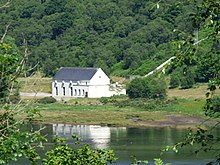
The Firth of Clyde is the mouth of the River Clyde. It is located on the west coast of Scotland and constitutes the deepest coastal waters in the British Isles. The firth is sheltered from the Atlantic Ocean by the Kintyre peninsula, which encloses the outer firth in Argyll and Ayrshire. The Kilbrannan Sound is a large arm of the Firth of Clyde, separating the Kintyre Peninsula from the Isle of Arran. Within the Firth of Clyde is another major island – the Isle of Bute. Given its strategic location at the entrance to the middle and upper Clyde, Bute played a vital naval military role during World War II.
The Isle of Bute, known as Bute, is an island in the Firth of Clyde in Scotland, United Kingdom. It is divided into highland and lowland areas by the Highland Boundary Fault.

A bouncing bomb is a bomb designed to bounce to a target across water in a calculated manner to avoid obstacles such as torpedo nets, and to allow both the bomb's speed on arrival at the target and the timing of its detonation to be pre-determined, in a similar fashion to a regular naval depth charge. The inventor of the first such bomb was the British engineer Barnes Wallis, whose "Upkeep" bouncing bomb was used in the RAF's Operation Chastise of May 1943 to bounce into German dams and explode underwater, with effect similar to the underground detonation of the later Grand Slam and Tallboy earthquake bombs, both of which he also invented.

The Holy Loch is a sea loch, a part of the Cowal peninsula coast of the Firth of Clyde, in Argyll and Bute, Scotland.

The X class was a World War II midget submarine class built for the Royal Navy during 1943–44. It was substantially larger than the original Chariot manned torpedo.
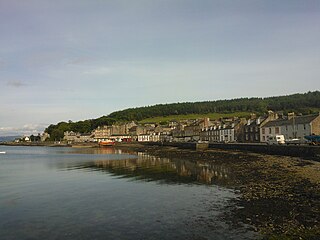
Port Bannatyne, is a coastal village on the Isle of Bute, Firth of Clyde, Scotland that is home to many steamers. Port Bannatyne developed into the 1900s as a quieter alternative to Rothesay. It is a popular harbour, with a small yacht marina and boatyard and an unusual 13-hole golf course rather than the standard 18.

His Majesty's Naval Base, Clyde, primarily sited at Faslane on the Gare Loch, is one of three operating bases in the United Kingdom for the Royal Navy. It is the navy's headquarters in Scotland and is best known as the home of Britain's nuclear weapons, in the form of nuclear submarines armed with Trident missiles.
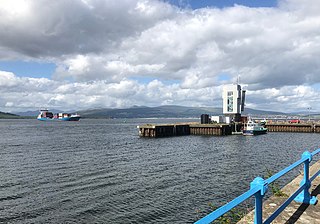
The Tail of the Bank is the name given to the anchorage in the upper Firth of Clyde immediately North of Greenock, between Inverclyde and Argyll and Bute. This area of the Firth gets its name from the deep water immediately to the west of the sandbank which marks the entrance to the navigable channel up the Estuary of the River Clyde.

Colintraive is a village in Argyll and Bute, Scotland. Once the site where cattle were swum across the narrows to the Isle of Bute, the MV Loch Dunvegan — a ferry operated by Caledonian MacBrayne — now provides a link to the island.

The Caledonian MacBrayne fleet is the largest fleet of car and passenger ferries in the United Kingdom, with 34 ferries in operation, 2 on charter and another 6 on order. The company provides lifeline services to 23 islands off the west coast of Scotland, as well as operating routes in the Firth of Clyde.

HMS Bonaventure was a submarine depot ship of the Royal Navy. She was initially built for civilian service with the Clan Line, but on the outbreak of the Second World War she was requisitioned by the Navy and after being launched, was converted for military service.

MV Jupiter was a passenger and vehicle ferry in the fleet of Caledonian MacBrayne in the Firth of Clyde, Scotland. She was the oldest of three "streakers" and the third River Clyde ship to bear the name 'Jupiter'. Her open car deck was accessible by stern and side ramps ro-ro. She entered service in 1974, and operated the Gourock to Dunoon crossing for much of her career. In 2006, she became the oldest vessel in the CalMac fleet and continued in service with them until 2010. Jupiter was sold for breaking in 2011.

MV Arran was a pioneering Firth of Clyde vehicle ferry introduced by Caledonian Steam Packet Company in 1953. She spent fifteen years on the Upper Clyde crossings, followed by five years at Islay. Initially hoist-loading, via side ramps, these were replaced by a stern ramp in 1973. During her final years with CalMac, she relieved across the network. Several unsuccessful attempts were made to turn her into a floating restaurant, before she was scrapped in 1993.
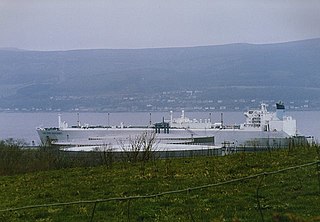
Gastor and Nestor were two LNG carriers built at the French shipyard Chantiers de l'Atlantique in Saint-Nazaire. Although delivered in 1976 both ships only entered real service in 1993, after their sale to Bonny Gas Transport Bermuda Shell, a subsidiary of Nigeria LNG Limited. Under their original names, the ships never transported any cargo.

Caledonian Maritime Assets Limited owns the ferries, ports, harbours and infrastructure for the ferry services serving the west coast of Scotland, the Firth of Clyde and the Northern Isles.

Loch Tarsan; is a freshwater loch and impounding reservoir located 13 kilometres Northwest of Dunoon, on the Cowal peninsula in Argyll and Bute, Scotland. This three-armed Reservoir extends into both Glen Tarsan and Glen Lean. It supplies water to the Striven Hydro-Electric Scheme. The larger of the two dams is 17.6 metres high and was completed in 1953. The water that is collected in the loch, are piped to the hydro-electric generating station, located at Ardtaraig, at the head of Loch Striven.

P & A Campbell was a shipping company based in Bristol which operated steamship services in the Bristol Channel between 1893 and 1979.
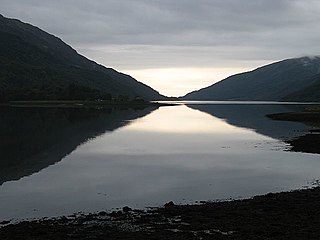
Ardtaraig is a hamlet lying at the head of Loch Striven on the Cowal peninsula, Argyll and Bute, West of Scotland. The hamlet is on the single track B836 road.
Captain William Richmond Fell, was a New Zealand naval officer. He served in the Royal Navy, mainly in submarines, and was involved in the development of human torpedoes and midget submarines during the Second World War.


